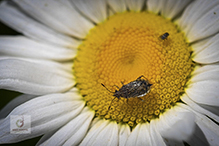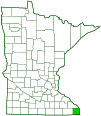scentless plant bug
(Arhyssus nigristernum)
Conservation • Description • Habitat • Ecology • Distribution • Taxonomy
Conservation Status |
|
|||||||
| IUCN Red List | not listed |
|||||||
| NatureServe | not listed |
|||||||
| Minnesota | not listed |
|||||||
Description |
||
Arhyssus nigristernum is a small scentless plant bug. It occurs in the United States from Maine to North Carolina, west to Minnesota and eastern Texas, and in Quebec and Ontario Canada. Adults are 3⁄16″ to ¼″ (5 to 6 mm) long and ⅛″ (2.5 to 3.0 mm) wide. Like all true bugs in the Rhopalidae family, they lack scent glands. This is the feature that gives the family its common name. The body is elongated oval, fairly hard, and thinly hairy. The color is somewhat variable. Light-colored individuals are pale brownish-yellow with dark markings. Dark individuals are dark reddish-brown to brownish-black, also with dark markings. The head is small, much narrower and somewhat shorter than the plate covering the thorax (pronotum). At the front of the head there is a rounded lobe that projects forward. There is a pair of large compound eyes on the sides of the head and a pair of small simple eyes (ocelli) between them. The ocelli are distinctly raised. The mouth parts are optimized for piercing and sucking. They take the form of a long, 4-segmented beak that extends along the underside of the body between the legs. The two lower jaw-like structures (maxillae) and two lower lips do not have feeler-like structures (palps) attached. The antennae are exposed, conspicuous, and long, much longer than the head. They have four segments. The first segment is short, not reaching the end of the head. The last segment is somewhat expanded and is pale at the tip. On the pronotum there is a thin pale longitudinal line extending from the front margin to the rear margin. The upper side of the abdomen is dark brown or black with a pale X-shaped spot in the middle. The last segment has a black spot at the tip. The flattened border of the abdomen (connexivum) is conspicuously striped black and yellow. On the male the connexivum is narrowly exposed, on the female it is more broadly exposed. On the female the last segment of the abdomen is pointed when viewed from above. On the male it is rounded. There are two pairs of wings, and they are held flat over the body when at rest. Between and at the wing bases there is a triangular plate (scutellum). The scutellum has a thin longitudinal line in the middle and an oblique pale stripe on each side. The forewings (hemelytra) on the mature adult are transparent and as long or only slightly longer than the abdomen. They have a thickened section at the base and a thin membranous section at the tip with a clear dividing line between the two. The thickened basal part is comprised of a narrow area (clavus) behind the scutellum when the wings are closed, and the remaining broad marginal area (corium). The veins on the corium are pale with black dots. The membranous section has many veins. The legs are dull yellow with numerous dark spots and speckling but without a series of rings. On the hind leg the third segment (femur) lacks prominent spines. The last part of each leg (tarsus), corresponding to the foot, has only 3 segments. |
||
Size |
||
3⁄16″ to ¼″ (5 to 6 mm) |
||
Similar Species |
||
Habitat |
||
|
||
Ecology |
||
Season |
||
|
||
Behavior |
||
|
||
Life Cycle |
||
|
||
Larva Food |
||
|
||
Adult Food |
||
|
||
Distribution |
||||
|
Sources |
|||
| 7/3/2022 | ||||
Occurrence |
||||
|
||||
Taxonomy |
|||
Order |
Hemiptera (True bugs, Hoppers, Aphids, and Allies) | ||
Suborder |
Heteroptera (True Bugs) | ||
Infraorder |
Pentatomomorpha | ||
Superfamily |
Coreoidea (leaf-footed bugs and allies) | ||
Family |
Rhopalidae (scentless plant bugs) | ||
Subfamily |
Rhopalinae | ||
Tribe |
Niesthreini | ||
Genus |
Arhyssus | ||
Synonyms |
|||
Arhyssus bohemani Corizus bohemani Corizus nigristernum |
|||
Common Names |
|||
Neither the genus nor the species has a common name. The common name for the family Rhopalidae is scentless plant bugs, and it is applied here for convenience. |
|||
Glossary
Connexivum
In Heteroptera: the enlarged, flattened margins of the abdomen. Plural: connexiva.
Corium
The thickened basal portion of the front wing that lies between the clavus and the membrane of insects in the family Hemiptera. Plural: coria.
Femur
On insects and arachnids, the third, largest, most robust segment of the leg, coming immediately before the tibia. On humans, the thigh bone.
Hemelytron
The forewing of true bugs (order Hemiptera), thickened at the base and membranous at the tip. Plural: hemelytra.
Ocellus
Simple eye; an eye with a single lens. Plural: ocelli.
Palp
Short for pedipalp. A segmented, finger-like process of an arthropod; one is attached to each maxilla and two are attached to the labium. They function as sense organs in spiders and insects, and as weapons in scorpions. Plural: palpi or palps.
Pronotum
The exoskeletal plate on the upper side of the first segment of the thorax of an insect.
Scutellum
The exoskeletal plate covering the rearward (posterior) part of the middle segment of the thorax in some insects. In Coleoptera, Hemiptera, and Homoptera, the dorsal, often triangular plate behind the pronotum and between the bases of the front wings. In Diptera, the exoskeletal plate between the abdomen and the thorax.
Tarsus
On insects, the last two to five subdivisions of the leg, attached to the tibia; the foot. On spiders, the last segment of the leg. Plural: tarsi.
Tibia
The fourth segment of an insect leg, after the femur and before the tarsus (foot). The fifth segment of a spider leg or palp. Plural: tibiae.
Visitor Photos |
|||||
Share your photo of this insect. |
|||||
| This button not working for you? Simply email us at info@MinnesotaSeasons.com. Attach one or more photos and, if you like, a caption. |
|||||
Mike Poeppe |
|||||
 |
|||||
MinnesotaSeasons.com Photos |
|||||
|
|||||

Slideshows |
||

Visitor Videos |
|||
Share your video of this insect. |
|||
| This button not working for you? Simply email us at info@MinnesotaSeasons.com. Attach a video, a YouTube link, or a cloud storage link. |
|||
Other Videos |
|||

Created: 7/3/2022
Last Updated:


